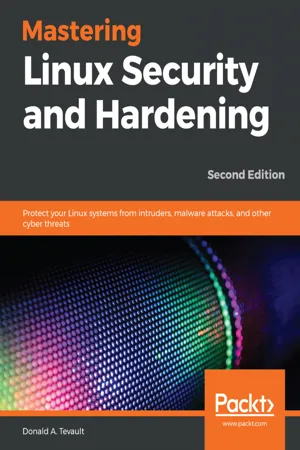
Mastering Linux Security and Hardening
Protect your Linux systems from intruders, malware attacks, and other cyber threats, 2nd Edition
Donald A. Tevault
- 666 Seiten
- English
- ePUB (handyfreundlich)
- Über iOS und Android verfügbar
Mastering Linux Security and Hardening
Protect your Linux systems from intruders, malware attacks, and other cyber threats, 2nd Edition
Donald A. Tevault
Über dieses Buch
A comprehensive guide to securing your Linux system against cyberattacks and intruders
Key Features
- Deliver a system that reduces the risk of being hacked
- Explore a variety of advanced Linux security techniques with the help of hands-on labs
- Master the art of securing a Linux environment with this end-to-end practical guide
Book Description
From creating networks and servers to automating the entire working environment, Linux has been extremely popular with system administrators for the last couple of decades. However, security has always been a major concern. With limited resources available in the Linux security domain, this book will be an invaluable guide in helping you get your Linux systems properly secured.Complete with in-depth explanations of essential concepts, practical examples, and self-assessment questions, this book begins by helping you set up a practice lab environment and takes you through the core functionalities of securing Linux. You'll practice various Linux hardening techniques and advance to setting up a locked-down Linux server. As you progress, you will also learn how to create user accounts with appropriate privilege levels, protect sensitive data by setting permissions and encryption, and configure a firewall. The book will help you set up mandatory access control, system auditing, security profiles, and kernel hardening, and finally cover best practices and troubleshooting techniques to secure your Linux environment efficiently.By the end of this Linux security book, you will be able to confidently set up a Linux server that will be much harder for malicious actors to compromise.
What you will learn
- Create locked-down user accounts with strong passwords
- Configure firewalls with iptables, UFW, nftables, and firewalld
- Protect your data with different encryption technologies
- Harden the secure shell service to prevent security break-ins
- Use mandatory access control to protect against system exploits
- Harden kernel parameters and set up a kernel-level auditing system
- Apply OpenSCAP security profiles and set up intrusion detection
- Configure securely the GRUB 2 bootloader and BIOS/UEFI
Who this book is for
This book is for Linux administrators, system administrators, and network engineers interested in securing moderate to complex Linux environments. Security consultants looking to enhance their Linux security skills will also find this book useful. Working experience with the Linux command line and package management is necessary to understand the concepts covered in this book.
]]>
Häufig gestellte Fragen
Information
Section 1: Setting up a Secure Linux System
- Chapter 1, Running Linux in a Virtual Environment
- Chapter 2, Securing User Accounts
- Chapter 3, Securing Your Server with a Firewall - Part 1
- Chapter 4, Securing Your Server with a Firewall - Part 2
- Chapter 5, Encryption Technologies
- Chapter 6, SSH Hardening
Running Linux in a Virtual Environment
- Unlike Windows, Linux was designed from the ground up as a multiuser operating system. So, user security tends to be a bit better on a Linux system.
- Linux offers a better separation between administrative users and unprivileged users. This makes it a bit harder for intruders, and it also makes it a bit harder for a user to accidentally infect a Linux machine with something nasty.
- Linux is much more resistant to viruses and malware infections than Windows is. Certain Linux distributions come with built-in mechanisms, such as SELinux in Red Hat and CentOS, and AppArmor in Ubuntu, that prevent intruders from taking control of a system.
- Linux is a free and open source software. This allows anyone who has the skill to audit Linux code to hunt for bugs or backdoors.
- Looking at the threat landscape
- Why every Linux administrator needs to learn about Linux security
- A bit about the threat landscape, with some examples of how attackers have, at times, been able to breach Linux systems
- Resources for keeping up with IT security news
- Differences between physical, virtual, and cloud setups
- Setting up Ubuntu Server and CentOS virtual machines with VirtualBox, and installing the Extra Packages for Enterprise Linux (EPEL) repository in the CentOS virtual machine
- Creating virtual machine snapshots
- Installing Cygwin on a Windows host so that Windows users can connect to a virtual machine from their Windows hosts
- Using the Windows 10 Bash shell to access Linux systems
- How to keep your Linux systems updated
Looking at the threat landscape
- Botnet malware: This causes a server to join a botnet that is controlled by a remote attacker. One of the more famous cases involved joining Linux servers to a botnet that launched denial-of-service (DoS) attacks against other networks.
- Ransomware: This is designed to encrypt user data until the server owner pays a ransom fee. But even after paying the fee, there's no guarantee that the data can be recovered.
- Cryptocoin mining software: This causes the CPUs of the server on which it's planted to work extra hard and consume more energy. Cryptocoins that get mined go to the accounts of the attackers who planted the software.